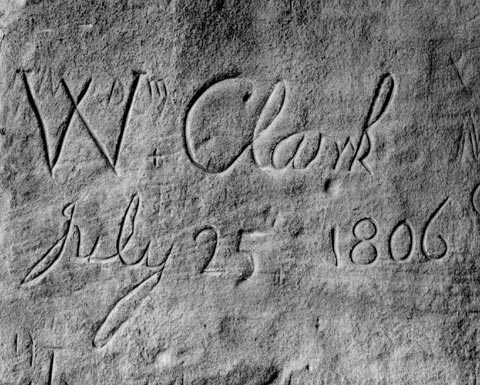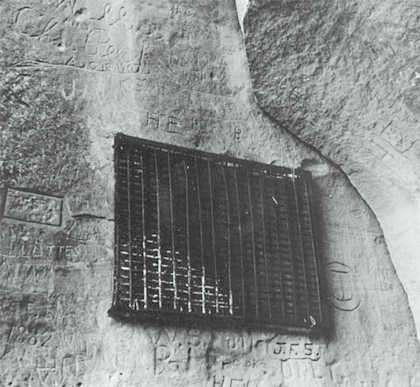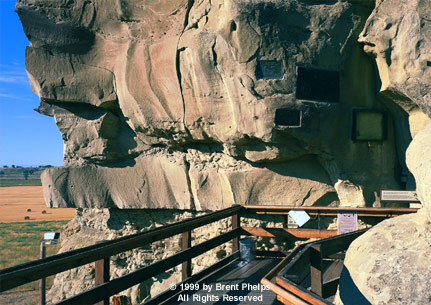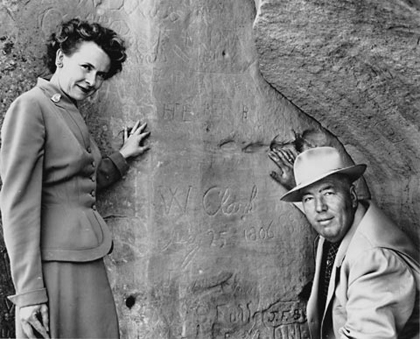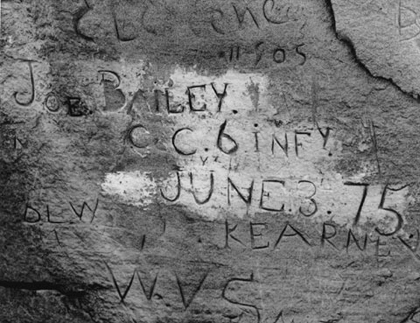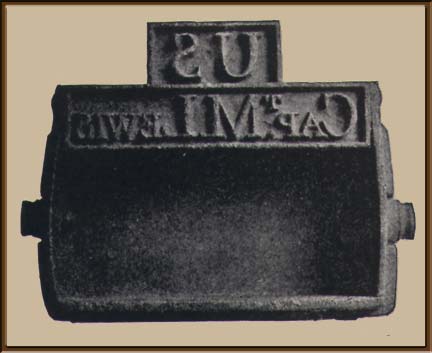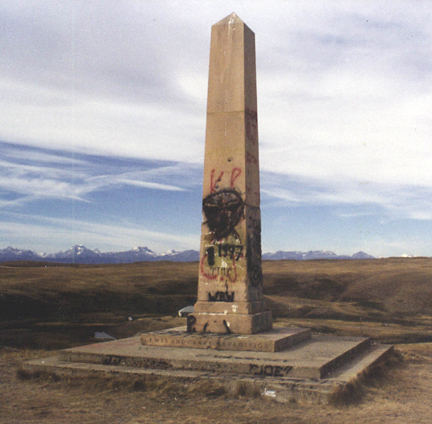Graffiti—properly sgraffiti: an Italian word meaning “to scribble.”[1]In today’s slang, a “tag” is basically a signature of some sort, either initials or full names. “Getting up” means to “hit up”—”tag” with paint … Continue reading
How did humans come by this primordial urge to leave their marks in public places? Is it communication or mindless doodling? Social commentary or political gesture? Art or abomination?
Members of the Lewis and Clark expedition carved, burned, or painted their names or initials—tags, in the modern writer’s lingo—and the dates when they did so, more than fourteen times according to the journals.They were practicing what had long been European explorers’ legitimate means for claiming dominion over other people’s land.[2]Bob Saindon, “They Left Their Mark: Tracing the Obscure Graffiti of the Lewis and Clark Expedition,” We Proceeded On, Vol. 13, No. 3 (August, 1987).
On this prominent landmark, William Clark scratched his name near an Indian petroglyph, of which he recorded a brief description: “The nativs have ingraved on the face of this rock the figures of animals &c.” François-Antoine Larocque, the Canadian fur company clerk who toured the lower Yellowstone a year prior to Clark’s trip, left us a few more details. He saw “a whitish perpendicular Rock on which is painted with Red earth a battle between three persons on horseback and 3 on foot.” Neither visitor hazarded a guess as to its meaning, and that “Red earth” has long since weathered away, so we can’t either.
Lieutenant James Bradley, who arrived there in April 1876 with Nicholas Biddle‘s version of the expedition’s journals in hand, knew about the petroglyph Clark and Larocque had seen, but it was almost worn away by the time he arrived. However, he had observed similar graffiti as he marched down the Yellowstone valley:
At the point where the road ascends from the Clark’s Fork bottom [at today’s Billings, about 40 miles west of Pompeys Pillar], the rocks are lavishly adorned with Indian hieroglyphics, some of them graven deeply in the face of the rock at a considerable height above the ground and in places difficult of access. I endeavored to learn their meaning from my scouts, but even the oldest of them were unable to tell much about them. They were placed there, they said, by spirits, and every few snows the spirits caused what they had written to disappear and replaced it with something else. The white men, they added, know more than the Crows and ought therefore to be better able than themselves to tell what the spirit meant.
Graffiti is inherently more or less cryptic—a piece of a puzzle. Only the writer and his or her cohorts fully understand what’s behind it.
Pompeys Pillar
As the Yellowstone began to draw increasing numbers of traders, trappers, soldiers, and emigrants around the middle of the 19th century, the number of irrepressible fools with suitable tools increased proportionately. After 1882, Northern Pacific passenger trains were routinely stopped nearby to allow tourists to climb the steps for a closer look. The superintendent of the Yellowstone Division had an iron grille anchored over Clark’s tag, to protect it from vandalism. It was removed in 1927 to enable professional stone cutters to deepen the inscription in several places where rain had eroded it, and was replaced in 1956 with a sheet of one-inch shatterproof glass set in a bronze frame.
“The nativs,” Clark wrote in his journal for 25 July 1806, “have ingraved on the face of this rock the figures of animals &c. near which I marked my name and the day of the month & year.” He had done the same thing in the same sort of setting at least once before. Back on July 12, 1804, near the mouth of the Big Nemaha River, in Nebraska, he wrote:
observed some Indian marks, went to the rock which jucted over the water and marked my name & the day of the month & year.
No trace of the earlier inscription has ever been found, so the one on Pompeys Pillar is the sole remaining material evidence of the Corps’ presence in the Northwest.
We don’t know what sort of instrument Clark used to engrave his signature, but we may suppose that he used something like a cold chisel. In any case, Private John Shields, the Corps’ blacksmith, was with Clark’s party, and he would have had a wide selection of suitable tools.
Over the years a number of other passersby have seized the opportunity to borrow a little status by scratching their tags over and around Clark’s, but none more blatantly than a certain cavalryman in April 1876.
Pillar Markers
To read the text of the four plaques in the photo, click below:
On the relatively sheltered face of Pompy’s Tower where Clark engraved his tag in 1806 are three expressions of official, collective graffiti, dignified in bronze. In 1928, the Billings chapter of Daughters of the American Revolution commemorated the patriotic significance of the Expedition with a plaque. In 1938, members of the Masonic Lodge in Billings acknowledged their own brotherly links with Meriwether Lewis and William Clark, both of whom were Freemasons (see Lewis as Master Mason). The third tablet is a memorial to Don Foote, a local real estate developer, farmer, and amateur historian, who purchased the land around it in 1965, to ensure its preservation.
Pompeys Pillar—editor Nicholas Biddle’s guess as to what Clark meant; the name-minding federal Board of Geographic Names deletes apostrophes—is now the center of a state park. Surveillance cameras help rangers apprehend a number of would-be graffitists each year, in the act of embellishing the famous rock with memorials to themselves.
A comprehensive study of the markings on Pompeys Pillar has recently been undertaken by Minot State University, so we know there is a total of some 2,500 tags on all surfaces of the rock, not counting those that were on chunks of sandstone that have fallen, face down, on the ground around it.[3]Information about these markers was written with the help of Dick Kodeski, Billings, Montana.
Lewis’s Branding Iron
Lewis’s Branding Iron
Olin D. Wheeler, The Trail of Lewis and Clark. See also Wheeler’s “Trail of Lewis and Clark”.
(2 vols, New York: G. P. Putnamπs Sons, 1904), Plate 60.
Width, 5.5 in.; Height 4 in.; Inside Depth, 1.5 in.
Lewis may have had his branding iron custom-made before he left the East, perhaps at Harpers Ferry, although there is no mention of it in existing records. Such tools commonly were used for marking wooden packing crates and barrels, and on leather bags, until the early 20th century. The frame below Lewis’s name would outline a space in which details such as numbers or letters could be burned or painted into the wood or leather, in order to organize parcels by contents or weight and, in this instance, to identify it as U.S. Government property. It was a distant forerunner of the rubber stamp, a sort of pre-digital barcode.
Lewis’s brand is frequently inferred from information in the journals that it was also used to blaze the expedition’s trail, so as to notify later travelers that others had preceded them, but that is an overstatement based on a questionable premise. Private Joseph Whitehouse once wrote that the captains “had several Trees branded, with their Names” on 4 June 1804, near the mouth of the Moreau River, about 140 miles up the Missouri. Perhaps they did that as a visible reminder for later reference by themselves or their agents, to identify that area as being rich in lead ore (or so they had been told). And when the men hid the red pirogue on an island at the mouth of the Marias River on 10 June 1805, Lewis recorded: “Put my brand on several trees standing near her,” and Sergeant Ordway added, “to prevent the Savages from disturbing her.” He may have used his branding instrument for that purpose, perhaps having been told by someone at Fort Mandan that natives regarded the white man’s handwriting as having supernatural powers.
On 20 April 1806, while camped above the Long Narrows of The Dalles, near today’s Columbia Hills State Park, Lewis mentioned that he had traded some elk skins, “old irons,” and two canoes for beads, thus reducing his inventory and gaining a little capital. This may explain why his “signature” iron was found in the Columbia River in the vicinity of The Dalles, Oregon, in the early 1890s.[4]Gary E. Moulton, ed., The Journals of the Lewis & Clark Expedition (13 vols., Lincoln: University of Nebraska Press, 1983–2001), 4:277n. Lewis’s branding iron is now in the possession of … Continue reading
Making Marks
In January 1796, James Mackay of the Commercial Company for the Discovery of the Nations of the Upper Missouri, a Spanish enterprise commonly called the Missouri Company, dispatched the young explorer and trader, John Evans, up the Missouri River “to discover a passage from the sources of the Missouri to the Pacific Ocean.” Among other things, he instructed Evans to:
. . . mark your route in all places where there will be a portage to pass from one river to another or from one water-fall to another by cutting or notching some trees or by some piles of stones engraved and cut; and take care to place in large letters Charles IV King of Spain and below Company of Missouri, the day, the month, and the year when you do this in order to serve as unquestionable proof of the journey that you are going to make.
The procedure was inherently powerful. Mackay warned Evans that if he were to come upon the Russian settlement that was rumored to exist somewhere north of California, “you will cease to make any sign of taking possession, for fear of having spring up with these foreigners any jealousy which would be prejudicial to the success of your journey.”[5]A. P. Nasatir, Before Lewis and Clark (2 vols., Lincoln: Bison Book, 1990), 413.
Three years earlier, Alexander Mackenzie, in search of a navigable water route across North America, had left his mark, his tag, at the end of his long trek from Montreal to the Pacific Ocean:
I now mixed up some vermilion in melted grease, and inscribed, in large characters, on the South East face of the rock on which we had slept last night, this brief memorial—”Alexander Mackenzie, from Canada, by land, the twenty-second of July, one thousand seven hundred and ninety-three.”[6]Walter Sheppe, ed., Journal of the Voyage to the Pacific: Alexander Mackenzie (Mineola, NY: Dover, 1995), 239.
Similarly, at their camp on Chinook Point (“Point Distress”) on 23 November 1805, William Clark marked his name, “the Day of the month & year on a Beech trees & (By Land). Capt. Lewis Branded his and the men all marked their nams on trees about the Camp.” A modern graffiti writer might call that a “throwup.”
At times the men of the Corps added “U.S.” to their tags, as well as the latitude of the place if Lewis had taken the necessary observations.
They marked their passage almost from the start. On 23 May 1804, two days after leaving St. Charles, Missouri, they stopped to inspect Tavern Cave where, Clark said, “many names are wrote up on the rock. Mine among others.”
Modern Graffiti
The obelisk pictured here stands a few yards north of U.S. Highway 2 on the Blackfeet Indian Reservation, a few miles south of the presumed location of Camp Disappointment, which is on private land. It was erected in the 1890s by the Great Northern Rail. The inscription, partly obliterated by the “going over,” reads, “July 22, 1806/Farthest point west on Capt Lewis trip up the Marias River.” On the western horizon is the spectacular Rocky Mountain Front.
Graffiti covers all surfaces of the monument, as high as a person can reach, with tags over tags. It’s been “hit up” and “gone over.” From the perspective of white culture, a historic shrine has been defiled. On the other hand, considering the fact that the only blood spilled on the entire Lewis and Clark expedition was that of two Blackfeet men, tribal members have no reason to respect a monument to Lewis’s presence on their turf.
Consequences
Mene, mene, Tekel Upharsin
“Thou hast been weighed in the balances,
and art found wanting.”
The Corps of Discovery’s graffiti served a simple political purpose, although individuals may have taken a personal delight in participating in the practice. But they were just leaving their tags—their names, as Clark did on Pompy’s Tower, or their initials. Compared with today’s well known urban styles, they didn’t do any “crazy big wildstyle burners.” No “getting up in a major way.” No dissing the locals. And no latrinalia that we know of.
Of course, locals such as the Crow people might have thought of it another way. For the expedition’s purposes, their tags needed to be in conspicuous places, and Pompy’s Pillar, iish-biia ah-naac’he to the Crows, was definitely that. Even if the Crows interpreted Clark’s graffiti as a claim to ownership, they might have dismissed it as arrogant at worst, or frivolous at best. Bad taste, perhaps, like defiling a sacred site, since this was a place for vision quests. In future years it may have implied a lingering presence that was as offensive and disquieting to them as unexpected and inexplicable graffiti in our own neighborhoods is to us today.
It was indeed a political statement, indecipherable inasmuch as its readers had no written language themselves, or at least no alphabet akin to ours. They couldn’t, at the time, have recognized Clark’s graffiti as his name, and it clearly was not a pictograph. The date, also, would have been meaningless to the Crow, who lacked numerals identical with ours. That four of the digits represented a certain year would have been incomprehensible, too, since they knew nothing of the “Christian era.” The letters and numbers would have been as cryptic to them as Arab or Hebrew characters are to most Americans. The Indians couldn’t imagine the sounds of them, much less make sense of them. In Indian terms, they were mysterious—pure Medicine. As to whether it was good or bad medicine we cannot know, but when we find graffiti on a shrine of our own, we tend to assume we have somehow, by someone unknown, been “weighed in the balances and found wanting.”
On at least one occasion—at the mouth of the Marias—the Corps of Discovery is known to have left tags with bad medicine in mind. Sergeant Ordway, perhaps copying Clark’s entry, reported on 10 June 1805:
We halled out our largest perogue [the red one] in the middle of an Island in the North fork opposite the point, and made hir fast between Some trees, & branded Several trees to prevent the Savages from disturbing hir.
The graffiti the captains and their men painted or carved on trees is all long gone.[7]There is a so-called “Clark Tree” near the west end of their route across the Bitterroot Mountains that once appeared to bear Clarkπs initials. But if it did, we canπt make them out … Continue reading There was no political need for it to last as long as Clark’s tag on Pompy’s Tower has. But the fact that it has endured, thanks to the efforts of many individuals since the late 19th century, has made it a historic shrine deemed worthy of the full protection of our government.
Clark’s graffiti still does precisely what he intended it to do. It simply says “William Clark was here on July 25, 1806.” To many of us it is a visible link to our nation’s early history—it is Good Medicine.
Further Reading
See the Graffiti Glossary at http://www.at149st.com/glossary.html and the history of the art at http://www.at149st.com/hpart1.html and http://www.at149st.com/hpart2.html.
Pompeys Pillar is a High Potential Historic Site along the Lewis and Clark National Historic Trail managed by the U.S. National Park Service. The site and interpretive center is managed by the U.S. Bureau of Land Management.—ed.
Notes
| ↑1 | In today’s slang, a “tag” is basically a signature of some sort, either initials or full names. “Getting up” means to “hit up”—”tag” with paint or ink—any surface with graffiti. One writer covering up another writer’s tag is “going over.” “Throwup” is another term for a quick, simple tag. |
|---|---|
| ↑2 | Bob Saindon, “They Left Their Mark: Tracing the Obscure Graffiti of the Lewis and Clark Expedition,” We Proceeded On, Vol. 13, No. 3 (August, 1987). |
| ↑3 | Information about these markers was written with the help of Dick Kodeski, Billings, Montana. |
| ↑4 | Gary E. Moulton, ed., The Journals of the Lewis & Clark Expedition (13 vols., Lincoln: University of Nebraska Press, 1983–2001), 4:277n. Lewis’s branding iron is now in the possession of the Oregon Historical Society. |
| ↑5 | A. P. Nasatir, Before Lewis and Clark (2 vols., Lincoln: Bison Book, 1990), 413. |
| ↑6 | Walter Sheppe, ed., Journal of the Voyage to the Pacific: Alexander Mackenzie (Mineola, NY: Dover, 1995), 239. |
| ↑7 | There is a so-called “Clark Tree” near the west end of their route across the Bitterroot Mountains that once appeared to bear Clarkπs initials. But if it did, we canπt make them out now, for the lofty 250-year-old Western white pine (Pinus monticola Dougl. ex D. Don) has sealed the old wound with a scar, and the letters are no longer legible. Some rock carvings have been found along the trail that have been attributed to members of the Corps of Discovery, but no corroboration resides in the available journals, and they may thus be only later coincidences, if not outright hoaxes. |
Experience the Lewis and Clark Trail
The Lewis and Clark Trail Experience—our sister site at lewisandclark.travel—connects the world to people and places on the Lewis and Clark Trail.
Discover More
- The Lewis and Clark Expedition: Day by Day by Gary E. Moulton (University of Nebraska Press, 2018). The story in prose, 14 May 1804–23 September 1806.
- The Lewis and Clark Journals: An American Epic of Discovery (abridged) by Gary E. Moulton (University of Nebraska Press, 2003). Selected journal excerpts, 14 May 1804–23 September 1806.
- The Lewis and Clark Journals. by Gary E. Moulton (University of Nebraska Press, 1983–2001). The complete story in 13 volumes.
